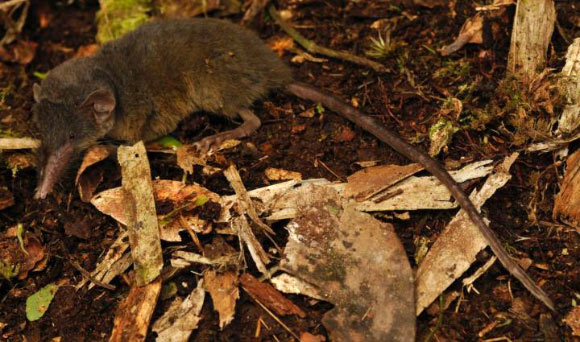A team of researchers from Louisiana State University, Indonesian Institute of Sciences, Museums Victoria and the University of Melbourne has discovered a new species of musk shrew living on Indonesia’s Sulawesi Island.

The Sulawesi hairy-tailed shrew (Crocidura caudipilosa). Image credit: Kevin Rowe, Museums Victoria.
The newfound species belongs to Crocidura (commonly called musk shrews or white-toothed shrews), a genus of over 180 species in the subfamily Crocidurinae.
Named the Sulawesi hairy-tailed shrew (Crocidura caudipilosa), the species is slender with gray-brown fur on its back and silver-gray fur on its belly.
Its tail is slightly longer than the combined length of its head and body and is covered with long bristles and hair, which make the distinctive tail very hirsute.
In fact, no other shrew species in Indonesia, Malaysia or the Philippines is known to have such thick, long hair on its tail; however, some shrew species in Africa have very hairy tails.
The Sulawesi hairy-tailed shrew climbs trees whereas most shrews live primarily on the ground, as far as anyone knows.
“There was no doubt that this was a new species. There isn’t another species on the island that has as much hair on its tail, in terms of shrews,” said lead author Dr. Jake Esselstyn, a researcher in the Museum of Natural Science and Department of Biological Sciences at Louisiana State University.
The Sulawesi hairy-tailed shrew was found on nine mountains across Sulawesi at various elevations from 1,500 feet to 4,800 feet.
“Tropical diversity is still not well documented even for mammals with a wide distribution on this island. This discovery shows how little we still know about mammal diversity,” Dr. Esselstyn said.
The real challenge was figuring out which shrew is its closest relative and how the new species fits into the shrew family tree.
Shrews’ features do not change very much over time, which means closely related species tend to look very similar and are hard to distinguish from each other. This has posed a challenge for mammalogists in the past to discover new shrew species.
“Genetic data have revolutionized what we can distinguish between shrews,” Dr. Esselstyn said.
“A lot of species are first recognized as being genetically distinct, then we look at its morphology, or physical features.”
A paper on the discovery was published in the Journal of Mammalogy.
_____
Jacob A. Esselstyn et al. 2019. A new climbing shrew from Sulawesi highlights the tangled taxonomy of an endemic radiation. Journal of Mammalogy 100 (6): 1713-1725; doi: 10.1093/jmammal/gyz077







